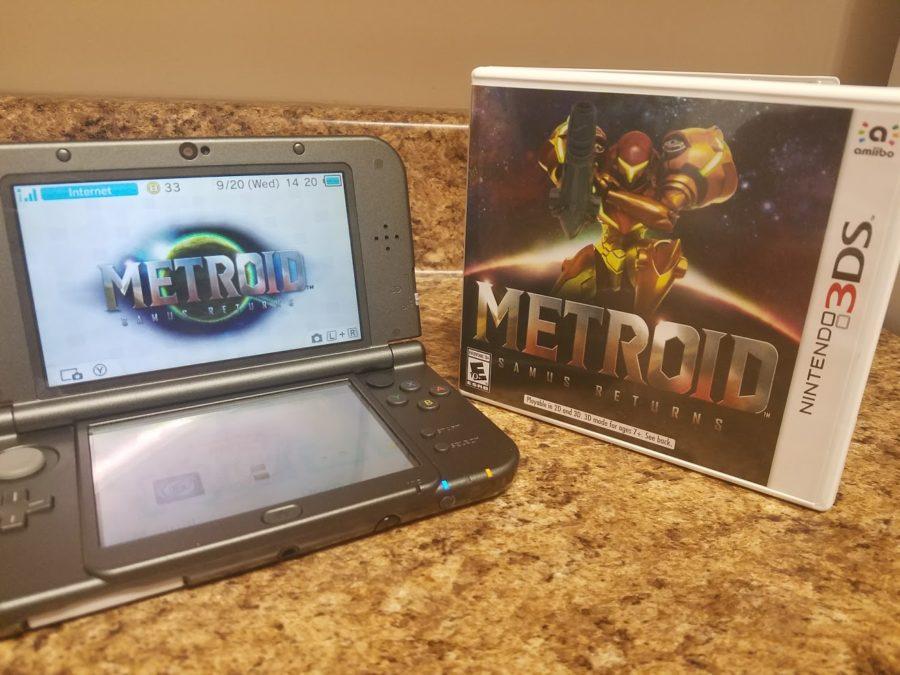- Ames247
- Ames247 / Gaming
- App Content
- App Content / Lifestyle
- Limelight
- Limelight / Music
- Limelight / Music / Campus Music Sub
- Limelight / Reviews
- Limelight / Visual Media
- Limelight / Visual Media / Videogames
Review: “Metroid: Samus Returns”
Alexander Gray/ Iowa State Daily
Metroid Samus Returns for the Nintendo 3DS
September 20, 2017
Console: Nintendo 3DS Released: 9/15/17
After six years without without a new game in the franchise, and seven without a main entry, the Metroid series returns, with the aptly named “Metroid: Samus Returns” for the Nintendo 3DS. “Samus Returns” is a complete overhaul of the original Gameboy game, “Metroid II: Return of Samus,” and is nearly unrecognizable to the original. There are so many quality-of-life improvements and new gameplay mechanics that make it stand out as a solid entry into the Metroid series.
Story and Presentation
After Mother Brain and the space pirates tried to use the Metroids as the ultimate weapon, the Galactic Federation has dispatched the bounty hunter Samus Aran to SR388 to eradicate the Metroid species once and for all. Outside of the opening cutscene that catches you up to speed, there is almost zero storytelling in the game, although in depth storytelling has never been a cornerstone of the franchise.
Instead, Samus Returns focuses on creating an atmosphere around SR388. As always, the Metroid series doesn’t disappoint with world design, creating a truly alien environment that is exciting to explore. It’s just a shame that the hardware limitations of the 3DS’ 240p screen hold it back from looking as good as it would on a higher quality screen, such as Nintendo’s newest handheld/console hybrid, Switch.
Gameplay
Samus Returns follows up from “Metroid: Other M” with fluid movement, making traversing the dangerous environment of SR388 a simple task. Samus switches between running, moon-jumping, and rolling around in morph ball mode, with gameplay that is easy to learn and difficult to master. As you unlock more abilities, you have to become increasingly aware of your environment, and the required ability to kill certain enemies or interact with the world.
A new mechanic to the series is the addition of Aeion Abilities, which includes a shield, and a scattershot ability for Samus’ cannon. While the abilities are fun, they can make things even more hectic, and difficult to keep on top of.
Another addition is the free-aim mode, a similar mechanic as one introduced in “Other M,” allowing the player to aim in 360°, while cementing the player in place, and is extremely useful in boss fights.
The exploration is just as fun as ever, with plenty of variation in environments, and plenty of power-ups to discover across the world.
While the fluid movement and combat have certainly enhanced the combat, it can, at times, get repetitive as you hunt down the 40 Metroids scattered across the planet. The little variation in the boss fights can make them feel like a chore at times.
Quality-of-life improvements
Recent Nintendo games, especially for the 3DS, have had the drawback of being too easy, adding in features such as walkthroughs or straight up invincibility for portions of their games.
Luckily, despite all the new improvements to the series, it never felt at the expense of difficulty, and “Samus Returns” remains challenging throughout.
The most important new improvement is one of the Aeion Abilities, Scan Pulse, which reveals a section of the map, and the location of Missile tanks, and energy tanks, eliminating the hours of trial and error spent in the previous games trying to locate them.
Teleport stations are also new to the series, reducing the amount of time spent when you inevitably have to backtrack in the game to collect power-ups with your newfound abilities.
Conclusion
Metroid: Samus Returns is a fantastic addition to the Metroid franchise, and is a great send off to the Nintendo 3DS as the console’s life cycle comes to an end.
9/10
Pros:
-
Solid entry in the nearly dead Metroid series
-
Major quality of life improvements
Cons:
-
Feels held back by hardware limitations
-
Combat can get repetitive at times







